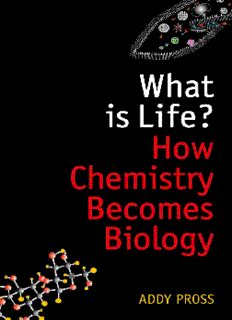
What is Life?: How Chemistry Becomes Biology PDF
Preview What is Life?: How Chemistry Becomes Biology
what is life? “By formulating a new stability kind in nature, Addy Pross has uncovered the chemical roots of Darwinian theory, thereby openinganovelrouteconnectingbiologytochemistryandphysics. Thatconnectionsuggeststhatabiogenesisandbiologicalevolution are one process, throwing exciting new light on the origin of life and offering a striking chemical explanation for life’s unusual characteristics. This book is more than worth reading—it stirs the readers’ mind and paves the way toward the birth of further outstandingideas.” AdaYonath,jointwinneroftheNobelPrizeforChemistry,2009 This page intentionally left blank What is Life? How Chemistry becomes Biology Q ADDY PROSS 1 3 GreatClarendonStreet,Oxford,OX26DP, UnitedKingdom OxfordUniversityPressisadepartmentoftheUniversityofOxford. ItfurtherstheUniversity’sobjectiveofexcellenceinresearch,scholarship, andeducationbypublishingworldwide.Oxfordisaregisteredtrademarkof OxfordUniversityPressintheUKandincertainothercountries #AddyPross2012 Themoralrightsoftheauthorhavebeenasserted FirstEditionpublishedin2012 Impression:1 Allrightsreserved.Nopartofthispublicationmaybereproduced,storedin aretrievalsystem,ortransmitted,inanyformorbyanymeans,withoutthe priorpermissioninwritingofOxfordUniversityPress,orasexpresslypermitted bylaw,bylicenceorundertermsagreedwiththeappropriatereprographics rightsorganization.Enquiriesconcerningreproductionoutsidethescopeofthe aboveshouldbesenttotheRightsDepartment,OxfordUniversityPress,atthe addressabove Youmustnotcirculatethisworkinanyotherform andyoumustimposethissameconditiononanyacquirer BritishLibraryCataloguinginPublicationData Dataavailable LibraryofCongressCataloginginPublicationData Dataavailable ISBN 978–0–19–964101–7 PrintedinGreatBritainby ClaysLtd,StIvesplc ToNella,Guy,andTamar,forwhatmylifeis This page intentionally left blank CONTENTS Prologue viii 1. LivingThingsaresoVeryStrange 1 2. TheQuestforaTheoryofLife 32 3. Understanding‘Understanding’ 43 4. StabilityandInstability 58 5. TheKnottyOriginofLifeProblem 82 6. Biology’sCrisisofIdentity 111 7. BiologyisChemistry 122 8. WhatisLife? 160 ReferencesandNotes 193 Index 199 vii PROLOGUE ‘IspenttheafternoonmusingonLife.Ifyoucometothinkofit,what aqueerthingLifeis!Sounlikeanythingelse,don’tyouknow,ifyou seewhatImean.’ PGWodehouse The subjectof this book addresses basic questionsthat have trans- fixedandtormentedhumankindformillennia,eversincewesought tobetterunderstandourplaceintheuniverse—thenatureofliving things and their relationship to the non-living. The importance of finding a definitive answer to these questions cannot be overstated—it would reveal to us not just who and what we are, butwouldimpactonourunderstandingoftheuniverseasawhole. Has the universe been fine-tuned to support life, as implied by proponents of the so-called anthropic principle? Or, to take a more Copernican view of man’s place in the universe, ‘is the human race just a chemical scum on a moderate-sized planet’, as arguedbyStephenHawking,thenotedphysicist?Awiderconcep- tualgulfwouldbehardtoconceive. Some65yearsagoanotherrenownedphysicist,ErwinSchro¨din- ger,wroteabookwhosecatchytitleWhatisLife?directlyaddressed theissue.IntheopeninglinesofthatbookSchro¨dingerwrote: Howcantheevents inspaceandtimewhichtake placewithin the spatial boundary of a living organism be accounted for by physics and chemistry? The preliminary answer...can be summarized as follows:Theobviousinabilityofpresent-dayphysicsandchemistry viii prologue toaccountforsucheventsisnoreasonatallfordoubtingthatthey canbeaccountedforbythosesciences. Sixty-five years have passed but despite the enormous advances in molecularbiologyinthoseyears,illuminatedbyalonglistofNobel prizes,wecontinuetostrugglewithSchro¨dinger’ssimpleanddirect question. And a struggle it is. Carl Woese, one of the leading biologists of the twentieth century, has recently gone as far as to claimthatthestateofpresent-daybiologyisreminiscentofthatof physicsattheturnofthetwentiethcentury,beforeAlbertEinstein, Niels Bohr, Erwin Schro¨dinger, and the other great twentieth- century physicists totally revolutionized the subject; that the time forbiology’srevolutionhasfinallycome.Strongsentimentsindeed! What is no less remarkable is that modern biology appears to be happily meandering along its current mechanistic path with most of its practitioners indifferent, if not oblivious, to the shrill cry for reassessment. Yes,itistruethatinthismoderneraweknowunequivocallythat thereisno´elanvital,thatlivingthingsaremadeupofthesame‘dead’ molecules as non-living ones, but somehow the manner in which thosemoleculesinteractinaholisticensembleresultsinsomething very special—us, and every other living thing on this planet. So, paradoxically,despitetheprofoundadvancesinmolecularbiology over the past half-century, we still do not understand what life is, how it relates to the inanimate world, and how it emerged. True, overthepasthalf-centuryconsiderableefforthasbeendirectedinto attempts to resolve these fundamental issues, but the gates to the PromisedLand seemas distant asever.Like a miragein the desert, just as the palm trees signalling the oasis seemingly materialize, ix
Description: